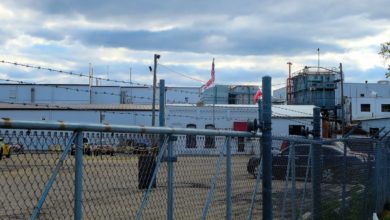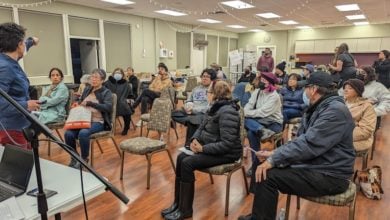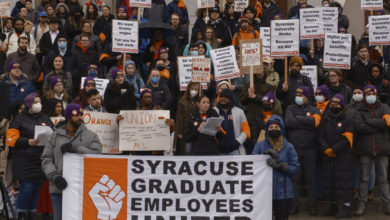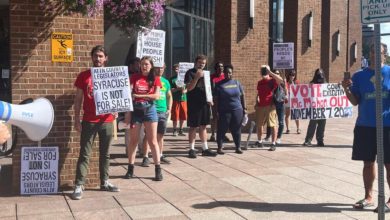Children in the city of Syracuse, New York, are nine times more likely to experience lead poisoning than children nationwide. This harrowing reality has been a concern for families in Syracuse for decades. Since lead poisoning through paint, soil, and dust were first discovered, children in specific regions of the city are still in danger even though this health crisis is entirely preventable.
A progressive coalition, including Families for Lead Freedom Now, Congolese Womens’ Association, Syracuse Peace Council, and the Syracuse branch of the Party for Socialism and Liberation, organized a People’s Public Hearing on Lead Poisoning on June 12. The hearing was meant to draw attention to the crisis and the local government’s unwillingness to respond. It took place outside City Hall, although the event was not sponsored or attended by Syracuse Common Councilors or Mayor Ben Walsh.
The coalition drafted and publicized a focused set of demands: 1) immediate mass-testing of children in Syracuse, including testing at WIC appointments; 2) full implementation of the Syracuse Lead Ordinance scheduled to go into effect in October 2020, but which the city and county governments have ignored; 3) public access to the Syracuse rental registry via the Internet; and 4) commitment to track and release data on lead by race and neighborhood.
The people demand full implementation of the lead ordinance and landlord accountability
The lead ordinance has still not gone into effect. It allows city codes inspectors to test homes for the presence of lead and issue violations to landlords who own properties with unabated lead paint.
Regarding the need for landlord accountability, Palmer Harvey, founder of the Syracuse Tenants Union, remarked: “Tenants in the city often pay up to 80% of their income to live in inadequate housing. Their landlords choose not to warn them of lead in the house. Even if the family moves, they’ll never get their money back and the landlord has no responsibility to not make the next tenant another victim of lead poisoning.”
A history of redlining and environmental racism
Organizers of the hearing drew attention to long-rooted racial and class inequities and the ways in which this health crisis mirrors environmental injustices people of color and the working class experience nationwide.
“Syracuse has a history of redlining, which defunded Black communities and steered Black people towards certain neighborhoods,” explained Lanessa Chaplin of the Volunteer Lawyers Project of CNY, Inc. She emphasized that these neighborhoods are now the most significantly impacted by lead poisoning. “If we could build quality, affordable housing, lead poisoning would no longer be a problem. But there has been no mass remediation effort for lead in housing, and now one in six Black boys nationwide are lead-poisoned.”
Redlining in Syracuse began in the mid-1930s as the Federal Housing Administration began creating secret residential maps. The maps were based on racial composition and the physical condition of buildings, which outlined what percent of a loan the U.S. government was willing to back. By freezing the ability of people living in the areas colored red to get loans, and heavily restricting those in yellow areas, the government ensured these areas would rarely see homes increase in value.
Even though redlining was legally banned in 1968, the damage had been done. The effects of redlining are still present today as the areas of extreme poverty in Syracuse — with 40% or more of residents in poverty — line up closely with the redlined and yellowlined neighborhoods from 1937. The highest concentrations of poverty between 41% and 80% can be found in some of the Northside, Southside, Southwest and Near Westside, where over 50% of residents are people of color.
Indeed, many women of color testified at the public hearing to share their own experiences with lead poisoning. Mothers, many of whom spoke in their native languages of French or Swahili, reported the devastating impact of lead paint in their family homes.
“Congolese women in the community have fled our country because of the war, and we thought we were coming to the land of peace,” one woman shared. “But when we got here, and our children became poisoned, we thought twice about this country. The government needs to partner with agencies coordinating refugees before refugees are housed. Test the houses before families are moved in!”
This crisis has always been preventable and demonstrates that it is up to the people to solve the problem. The socialist response to this crisis would begin with the immediate testing of land, homes, and other structures that are suspected to have lead. This would coincide with the testing of children for lead poisoning. Since housing would be a right, people could be temporarily moved out of their lead-contaminated homes while a lead remediation campaign takes place.
With housing as a right, no one would be required to fork over most of their income to landlords, as landlords would be a thing of the past. We must organize and put pressure on not only the city, but also the county and the state to make them clean up this toxic mess.





